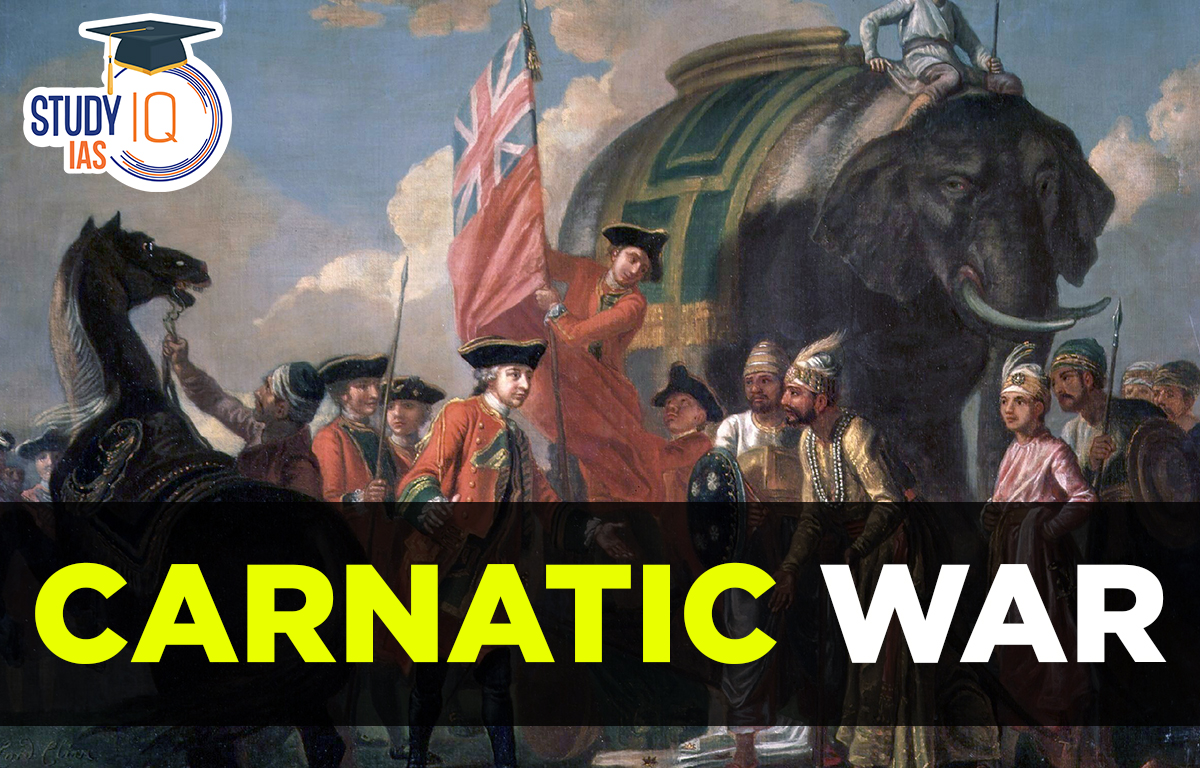Table of Contents
Carnatic War
The Carnatic Wars began in the eighteenth century at the base of the Indian Coastal. The Indian Military Services generally portrayed the Carnatic Wars as one of the wars they cherished most throughout their history. The significant Carnatic Wars are held in Hyderabad, a state in India. Despite coming to India with the goal of doing business, the British and the French eventually got embroiled in Indian politics.
Both had ideas for strengthening state control over the region. The main cause of the Carnatic wars was France and England’s naval and commercial rivalry. The three main phases of the Carnatic War began between 1746 and 1963. The Carnatic War was primarily a military conflict when it first started.
The Anglo-French rivalry in India reflected the ongoing rivalry between England and France throughout their respective histories. The struggle, which took the form of three Carnatic wars, especially in India, determined for sure that the English, not the French, were the superior candidates to impose their authority throughout India. According to the commercial administration, trade was the primary driving force behind the historical Carnatic War. One chapter of contemporary Indian history is the UPSC topic on the Carnatic Wars.
First Carnatic War
Anglo-French rivalry in Europe and a desire for control in India led to the First Carnatic War (1746–178). In 1740, the Austrian War of Succession broke out in Europe, sparking the Anglo-French conflict in India. French dominance in the eighteenth century sparked a rivalry between France and England in trade and the sea, notably in India. The rivalry between the French and British emerged in India during succession disputes among rajas, nawabs, and chieftains in south India.
The Coromandel coastline and its environs were given the name “Carnatic” by Europeans. The First Carnatic War saw the expansion of the Anglo-French War, which the Austrian War of Succession had begun, to Europe. The First Carnatic War’s turning point is recognised as the Battle of St. Thome (in Madras), which took place between French forces and the forces of Anwar-ud-din, the Maharaja of Carnatic, to whom the English asked assistance.
The English force led by Barnet seized some French ships in an effort to irritate France, despite the fact that France did not want hostilities to continue in India due to its poor position there. Due to this Anglo-French rivalry, their commercial businesses fought for supremacy in India. The French governor of Pondicherry, Dupleix, organised an army of Indian sepoys under the direction of French commanders.
France’s ambitions for India became imperialist after the nationalisation of the French East India Company in 1720. In 1745, a British naval raid on a French navy put even Pondicherry in peril. Dupleix and additional French forces from Mauritius defeated the attack and captured the English-held city of Madras. Another English attack on Pondicherry was launched, but this time they were soundly routed. The English requested aid from Anwaruddin Khan, the Nawab of Carnatic (Arcot).
The Nawab asked the French to return Madras to the British. Dupleix tried in vain to convince the Nawab that Madras would be eventually delivered to him. After that, the Nawab sent a huge army to fight the French troops. This army was defeated by comparatively minor French troops in Mylapore (modern-day Chennai) in 1746. In contrast to the well-trained forces of the European powers, this showed how inadequate the Indian monarchs’ military was. The conflict was resolved in 1748 by the Treaty of Aix-la-Chapelle, commonly known as the Treaty of Aachen.
First Carnatic War Significance
Even though the First Carnatic War had nothing to do with Indian political issues, India was still impacted by it. Throughout this struggle, India’s legislative and military gap was brought to the attention of the European nations. The Carnatic Nawab was unable to stop a firm from engaging in combat. Despite such, a small group of French forces defeated Nawab’s army.
European nations moved forward with their engagement with Indian governmental concerns as a result of Nawab’s inadequacy. The significance of this debate is emphasised by Prof. Dr. Jewell, who claims that “it prepared the basis for Dupleix’s trial and error and Clive’s works.” European countries were currently looking for political incomparability rather than just business. They essentially moved from the accommodating location to one of the masters, writes Mallison.
Under the leadership of Governor Duple of Pondicherry, the French won this struggle of progress. In addition, they received control of the Northern Government, which the French official Bussi had long dominated, rather than elevating their petitioners to lofty positions.
This was proved when a small French army defeated a large number of Carnatic Nawab. By protecting the French provinces in India from the English, the superior French Navy demonstrated the importance of naval force in the Anglo-French Rivalry.
Second Carnatic War
After the First Carnatic War was over, the British and French maintained their proxy conflict in India. Dupleix gained confidence after winning the first war against the Indian Nawab and believed he could now increase his power in South India. When Nizam of Hyderabad Asaf Jah I passed away in 1748 and a conflict for his succession started, he sensed a chance. Arcot experienced a problem as well.
Dupleix promised to support Chanda Sahib for Arcot and Nizam’s grandson Muzaffar Zang for Hyderabad. As a result, a triangular agreement between the French, Muzaffar Zang, and Chanda Sahib emerged. On the other hand, the British promised to back Muhammad Ali for Arcot and Nasir Zang for Hyderabad.
Nawab Anwaruddin of Arcot was initially assassinated by a faction commanded by the French, and his son Mohammad Ali fled to Trichinopoly. Nasir Zang was also attacked by the French-led force, and he was killed. Thus, it seemed as though Dupleix’s goal was about to come true after both of his British protégés were defeated.
Muzaffar Zang, a protégé of France, was assassinated shortly after. French swiftly installed his choice Salabat Zang as king and remained influential in Hyderabad for a number of years. The Nizam of Hyderabad provided them with the four wealthy Coromandel Coast districts known as the Northern Sircar in exchange for their military support.
The British had come to understand that they were in grave jeopardy. The only thing that gave them any hope was that Mohammad Ali, their protege, still controlled Trichinopoly. At this point, Robert Clive, the Company’s Clerk at the time, suggests attacking Arcot. Arcot was occupied after this proposal was approved. Chanda Sahib was taken prisoner and killed. Mohammad Ali received the title of Nawab of Arcot/Carnatic. Dupleix’s dreams were shattered with this.
More significant than the Battle of Plassey, the Siege of Arcot (1751) was a gallant accomplishment. Clive had become an English national hero as a result of the Siege of Arcot. The senior Prime Minister Pitt referred to him as a “heaven-born general.”
Second Carnatic War Significance
In terms of outcomes, the second Carnatic war took precedence over the first. Sunderlal claims that this is the stone that destroyed Dupleix’s and the French people’s imaginations inside the nation. The British are in a stronger position now than they were earlier. Interestingly, this struggle revealed the local rulers’ political vacuum to outsiders, allowing them to openly participate in Indian legislative matters.
But given that British strength under the direction of Robert Clive changed the terms of the fight in 1751 AD, the French victory was remarkably brief. French-backed petitioners for advancement were crushed by English authority under the leadership of Robert Clive within a year. In the meantime, the French and British needed to colonise Pondicherry.
Third Carnatic War 1757-63
In Europe, the battle between France and England erupted once more in 1756 as the Seven Years’ War, which coincided with the Third Carnatic War. A smaller-scale replica of the Seven Year’s War in Europe was the Third Carnatic War. The French attempts to establish a colonial empire in India were unsuccessful because of the Third Carnatic War. In 1757, the British Forces were successful in taking control of the French settlements at Chandranagar. Comte De Lally was in charge of the French soldiers in the south.
In 1760, Sir Eyre Coote’s British forces beat the French at the Battle of Wandiwash and then besieged Pondicherry. Following Wandiwash, the British captured Pondicherry, the French capital, in 1761. when the 1763 Treaty of Paris, which put an end to the Seven Years’ War, was signed.
Chandranagar and Pondicherry were returned to France in accordance with certain provisions of this treaty. The French were now permitted to operate commercial posts in India, but it was forbidden for French traders to run them. The French government likewise consented to assist the client regimes of the British. The French aspirations of an Indian Empire were effectively ended by this. British were now India’s main power.
Third Carnatic War Significance
The Third Carnatic War was unquestionably successful. The third conflict was put an end to by the Treaty of Paris (1763), which also allowed Pondicherry and Chandannagar to be ceded to France, but only for trade. Despite the fact that the agreement restored France’s manufacturing presence in India, following the war, French political influence in that country waned.
Following that, the French in India confined themselves to small territories and trade, just like their Portuguese and Dutch counterparts. The English became the dominating European force on the Indian subcontinent.
For instance, In the Third Carnatic War, the rivalry between the two European powers resurfaced. The French dictator Count de Lally’s invasion of Madras marked the beginning of this conflict. Sir Iroctut, a British official, crushed Lali. The British captured Pondicherry in 1761 and forced Lali to hand over Jinji and Karaikal. As a result, the French had to sign the Treaty of Paris with Britain after losing the Third Carnatic War battles in Wandiwash (1760 AD).
Carnatic Wars Important Facts
In India’s history, there have been a total of three Carnatic wars. The Carnatic Wars are discussed in the essential facts that are listed below. Due to the overwhelming effects of the Australian succession, the first Carnatic war began in 1744. The Carnatic Wars occurred between the years 1744 and 1748. The Anglo-French war took place in the Deccan region during the time.
The current French and Dutch states were originally descended from the civilian authority of the European region, hence the British government was first hesitant to accept this significant historical event. The decisive fight between the French and the powerful British rule was initially recognised as one of the historically significant conflicts in Indian history. The French and British administrations engaged in this specific conflict in the 17th century.
The third Carnatic war lasted from 1757 to 1763. The Australian nation aspired to recapture the nation of Silesia in 1758, which led to the start of the third Carnatic War, which lasted seven years. Initially, the governments of both France and Great Britain were eager to control the ancient Indian trades. The European region’s monarch was primarily to blame for the poor military and political performance. The French and English governments at first competed commercially.
Carnatic Wars Significance
The governments of France and India both experience frequent interference from the British government in their internal and private matters. The persistent intervention in procedural matters has caused disputes between the administration and the British parliament historically. Here is an illustration of the importance of the Carnatic Wars. This could also be what’s causing the current civil unrest.
The death of “Nizam-ul-Mulk,” the creator of the independent kingdom known as Hyderabad, was the real reason for the second Carnatic war. The French and English governments interfered with the native ruler’s attempts to advance their political position, which ultimately led to the outbreak of this battle. The second Carnatic war was fought between the two native rulers, who first fought one another to assist the foreign force.
The Indian War helped the Europeans realise that an Indian army that was much larger could be easily defeated by a much smaller, well-trained force. Furthermore, this battle successfully demonstrated the importance of naval might in the Deccan Anglo-French conflict.
Carnatic Wars UPSC
War in the Carnatic The modern Indian history portion of the UPSC test covers the topic. It’s crucial to understand the wars in Indian history. You can download the NCERT books for UPSC and other companion books for history subjects to better prepare for Indian history. For a reference of the types and patterns of questions asked in the exam, you can also download the question papers from the previous year. The candidates must be well knowledgeable of the history, significance, and other information relevant to the Carnatic Wars.


 Birsa Munda Birth Anniversary 2025: Life...
Birsa Munda Birth Anniversary 2025: Life...
 Military Innovations of Afghans and Turk...
Military Innovations of Afghans and Turk...
 Self-Respect Movement, History, Objectiv...
Self-Respect Movement, History, Objectiv...

























